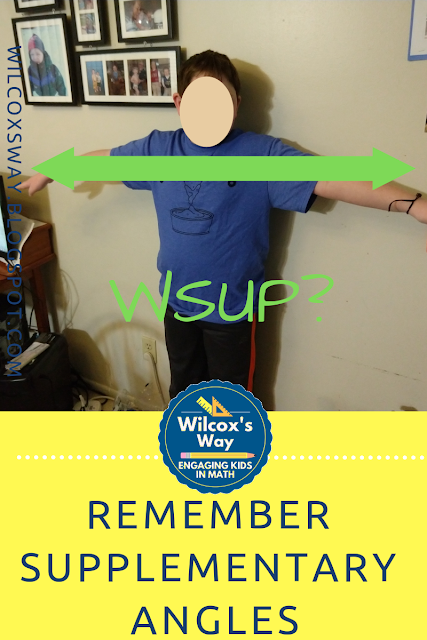Issue 1: Remembering the vocabulary. One pretty obvious issue is that students have to remember the definitions of complementary and supplementary. I have a pretty effective (although geeky) way that I help my students remember this.
For complementary angles, I ask my students, "You all like compliments, RIGHT?". At first they look at me confused. Then I ask again, and I start to get a lot of "I see what you did there" kind of nods as students realize way I said RIGHT so loud! So this becomes a mantra in our class for a week or two.
Now if you thought complementary was a geeky way to remember, hold your socks....supplementary is even better! :) For supplmenetary, I tell my students that I'm going to introduce a new "mathematical" way of greeting one another. You walk up to someone, with both arms held straight out (the straight line in supplementary angles) and say "WSUP?". At this point, I get quite a few groans and eye rolls, but as I walk in to class for the next couple of weeks, I will be greeted by a chorus of WSUPs!
Issue 3: Arithmetic errors. Now this one is pretty silly, and pretty easily corrected....but can we just take a moment and groan for all of the times that my students told me that the complement of a 32 degree angle would be 68 degrees. Students rush and forget to borrow when they subtract. The good news here is that usually a simple question like, "So 32 + 68 is 90?" and students quickly realize the mistake.
Issue 4: Setting up the equations. I had a few students that could easily find the complement or supplement, but going from that to a problem with an equation was difficult.
I found that having the student repeat the definition, and then use their own words to frame a question was really helpful. It would go something like this:
Me: Are these complementary or supplementary?
Student: Complementary
Me: What does complementary mean?
Student: Two angles that add up to 90.
Me: So what two things add up to 90 in this picture?
For many of my students, this was enough to help them make the connection and set up the equations.
Issue 5: Understanding what the answers meant. When we started working with equations, many students were confused about solving for the variable in equations like above, and the actual measure of the angle. We had many class discussions about this, and I made it a practice to ALWAYS ask for both the value of the variable and the measure of the angle.
What issues have you had with angle relationships, and how did you help your students? Comment below!
If you need some stations, notes or games to teach angle relationships, click here to see what I have in my TpT store. There's a free angle relationships golf game, as well lots of other stuff!


